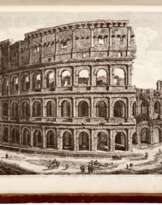ID 1076594
Los 71 | Luigi Rossini | Le antichita dei contorni di Roma, Rome, 1824-26, fine engraved views
Schätzwert
£ 8 000 – 12 000
Le antichita dei contorni di Roma. Rome: Presso l’autore e presso Scudellari, 1824-26
FIRST EDITION, large folio (535 x 750 mm.), engraved title and 72 ENGRAVED PLATES OF ROMAN ARCHITECTURE, RUINS, AND PLANS, contemporary half vellum gilt over marbled boards, letterpress title with central creases, final plate with short closed marginal tear, very faint dampstain to fore margin of about 10 plates, binding a bit rubbed
A MONUMENTAL WORK WITH FINE IMPRESSIONS. Millard describes Rossini as “the most important graphic illustrator of Rome in the nineteenth century”, depicting on a grand scale some of the finest architectural monuments outside the city of Rome.
The work is divided into four parts, each being a different geographical area: Tivoli (forty plates), Cora (eight plates), Albano and Castel Gandolfo (fifteen plates), and Praeneste and Tuscolo (ten plates); it includes views of monuments such as the Temple of the Sibyl and the Temple of Fortuna Primigenia, among many others.
Luigi Rossini (1790-1857) was born in Ravenna, and studied with Antonio Basoli and Giovanni Antolini in Bologna. In 1813 he won a government fellowship in Rome and began studying architecture, though with limited success. He eventually discovered his niche in printmaking, specifically topographical engraving, or “vedute,” geared toward the booming tourist market. Following in the footsteps of the great Piranesi, Rossini deployed careful observation, archaeological knowledge, and an extraordinary work ethic to produce an outstanding range of engravings. In the present work, Piranesi’s influence is felt in a number of ways; for example, many of the viewpoints are the same ones used by Piranesi in his own celebrated views in and around Rome, and, as Millard tells us, Rossini’s “formal adherence to Piranesi is still evident in the accentuated chiaroscuro, the choice of subjects and the ways in which they are framed, and the composition of the part-title pages in which architectural and archaeological fragments are mixed in apparent disorder.” Rossini’s views are especially lauded for his use of light and the way in which he treats the immense forms of dark masonry to suggest size and develop perspective. The majority of these illustrations also include images of contemporary people mingling in the foreground—some plates even depict excavation work being carried out—adding a sense of modernity and vitality to the crumbling ruins.
This copy was once owned by George Fredrick Nott (1767-1841), a Church of England clergyman and literary editor. According to ODNB, “In his parishes he repaired rectories and built new schoolhouses, but this enthusiasm for architecture later led to his (literal) downfall. As prebendary of Winchester he superintended repairs to the cathedral, and on 6 January 1817, while thus engaged, he fell a distance of some 39 feet, injuring his head”, and never fully recovered. His library, sold in Winchester in 1842, contained some 12,500 volumes.
| Kategorie des Auktionshauses: | Drucke, Graphik, Bücher |
|---|
| Kategorie des Auktionshauses: | Drucke, Graphik, Bücher |
|---|
| Adresse der Versteigerung |
Sotheby´s 34-35 New Bond Street W1A 2AA London Vereinigtes Königreich | |
|---|---|---|
| Vorschau |
| |
| Telefon | +44 (0) 20 7293 5000 | |
| Telefon | +1 212 606 7000 | |
| Nutzungsbedingungen | Nutzungsbedingungen |








